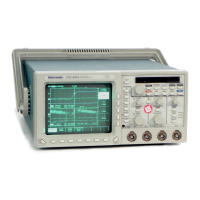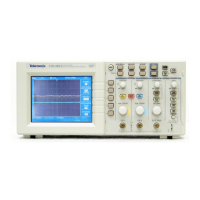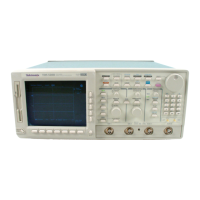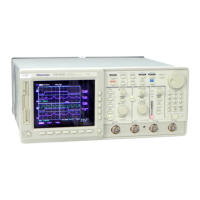Glossary
Glossary–2
TDS 420A, TDS 430A, TDS 460A & TDS 510A User Manual
Envelope acquisition mode
A mode in which the oscilloscope acquires and displays a waveform that
shows the variation extremes of several acquisitions.
Equivalent-time sampling (ET)
A sampling mode in which the oscilloscope acquires signals over many
repetitions of the event. The digitizing oscilloscope use a type of equivalent
time sampling called random equivalent time sampling. It utilizes an internal
clock that runs asynchronously with respect to the input signal and the signal
trigger. The oscilloscope takes samples continuously, independent of the
trigger position, and displays them based on the time difference between the
sample and the trigger. Although the samples are taken sequentially in time,
they are random with respect to the trigger.
Hi Res acquisition mode
An acquisition mode in which the digitizing oscilloscope averages all
samples taken during an acquisition interval to create a record point. That
average results in a higher-resolution, lower-bandwidth waveform. That
mode only works with real-time, non-interpolated sampling.
Holdoff, trigger
A specified amount of time after a trigger signal that elapses before the
trigger circuit will accept another trigger signal. Holdoff helps ensure a
stable display.
Interpolation
The way the digitizing oscilloscope calculates values for record points when
the oscilloscope cannot acquire all the points for a complete record with a
single trigger event. That condition occurs when the oscilloscope is limited
to real time sampling and the time base is set to a value that exceeds the
effective sample rate of the oscilloscope. The digitizing oscilloscope has two
interpolation options: linear or sin(x)/x interpolation.
Linear interpolation calculates record points in a straight-line fit between the
actual values acquired. Sin(x)/x computes record points in a curve fit
between the actual values acquired. It assumes all the interpolated points fall
in their appropriate point in time on that curve.
Main menu buttons
Bezel buttons under the main menu display. They allow you to select items
in the main menu.
Pixel
A visible point on the display. The oscilloscope display is 640 pixels wide
by 480 pixels high.
Pop-up menu
A sub-menu of a main menu. Pop-up menus temporarily occupy part of the
waveform display area and are used to present additional choices associated

